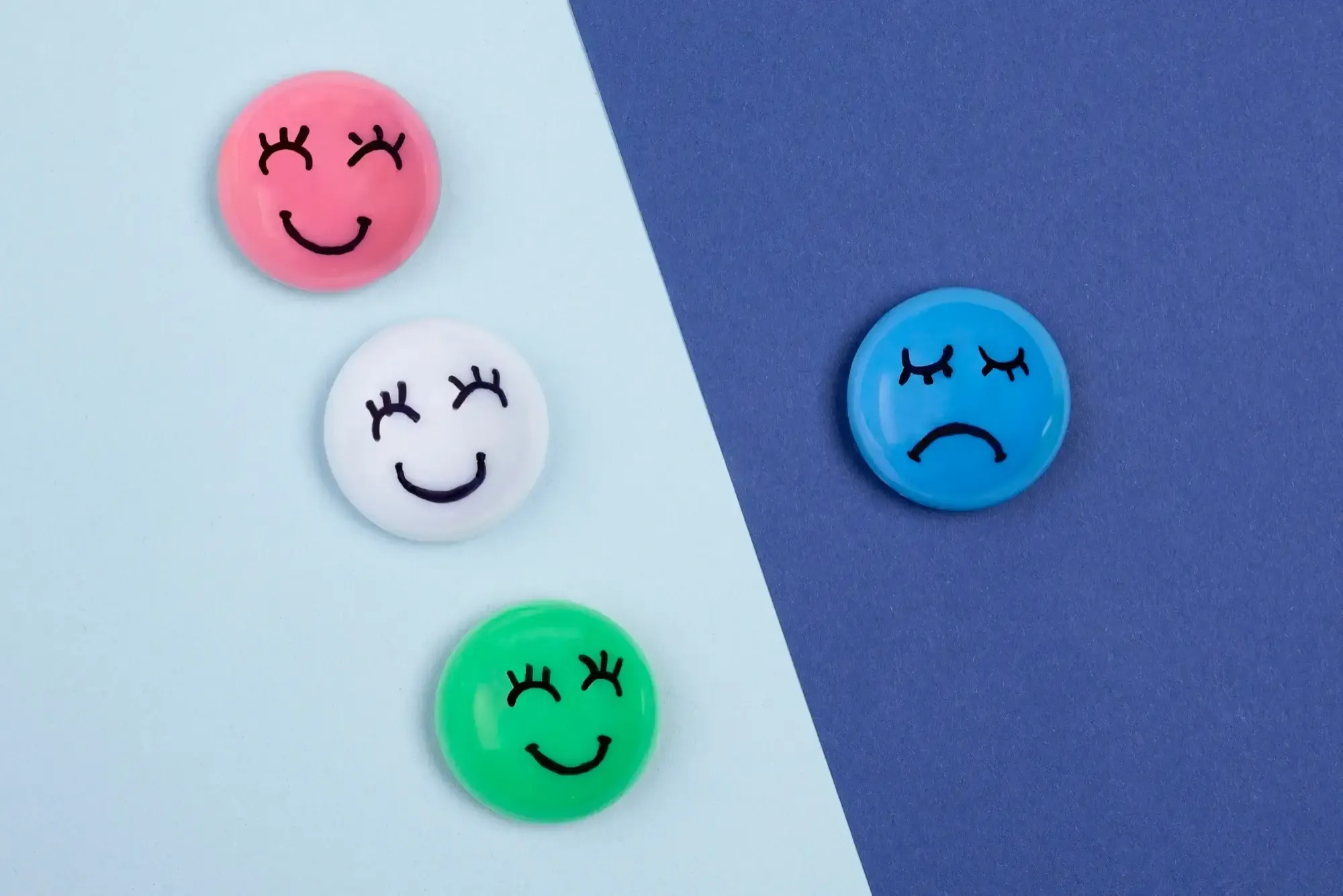Borderline Personality Disorder (BPD) vs. Bipolar Disorder: Understanding the Differences

Are you feeling confused about the difference between Borderline Personality Disorder (BPD) and Bipolar Disorder? It’s easy to mix them up, especially since they share some overlapping symptoms. However, they have distinct effects on emotions, behavior, and relationships.
By understanding how they differ, you can better recognize the signs, offer support to others, or find the right treatment for yourself. Let’s take a closer look at Borderline Personality Disorder (BPD) vs. Bipolar Disorder:
Borderline personality disorder vs. bipolar disorder
Before we go into specifics, let’s take a quick look at what these two conditions are:
What is borderline personality disorder (BPD)?
If you have BPD, you might feel like your emotions are constantly on a roller coaster, and your relationships might feel unstable or overwhelming. It is a mental health disorder that affects the way you think and feel about yourself and others.
Some signs to look out for:
-
Do you feel a deep fear of being abandoned, even in stable relationships?
-
Have you noticed rapid changes in your mood that last just a few hours or a day?
-
Do you struggle with impulsive behaviors, like overspending or risky decisions?
Around 1.6% of adults in the U.S. are diagnosed with BPD, but the real number might be higher. If any of this feels familiar, you’re not alone.
What is bipolar disorder?
Unlike BPD, bipolar disorder is a mood disorder. It’s characterized by shifts in mood, energy, and activity levels that can last for days, weeks, or even months. These shifts occur in cycles, alternating between high periods (manic or hypomanic episodes) and low periods (depressive episodes).
Here are a few types of bipolar disorder:
-
Bipolar I: You might experience full-blown manic episodes, where you feel invincible or extremely irritable. These can last for at least a week and can be so intense that people often need hospitalization.
-
Bipolar II: In this type, you experience hypomania, which is a less extreme high. However, the depressive episodes can be long and really difficult to handle.
-
Cyclothymia: This is a milder form with less severe mood swings. But they still disrupt your daily life and may last for at least two years.
Globally, about 0.53% of people live with bipolar disorder. It often begins in your late teens or early adulthood.
Symptoms of borderline personality disorder vs. bipolar disorder
While there booth BPD and bipolar disorder share overlapping characteristics, there are some differences in their symptoms:
If you have BPD, you might feel:
-
A strong fear of being abandoned, which can lead you to act clingy or push people away when you're afraid they'll leave.
-
Mood swings that change really quickly—sometimes in just a few hours or a day.
-
Impulsive urges, like overeating, reckless driving, or making snap decisions without thinking.
-
A sense of emptiness or like you're lacking a clear purpose in life.
-
Difficulty controlling your anger, which might lead to outbursts or getting really upset over small things.
These symptoms often come and go quickly, sometimes within hours. They’re tied to how you feel about yourself and how you relate to others.
On the other hand, if you have bipolar disorder, you might experience:
-
Manic episodes: Feeling super energetic, needing very little sleep, feeling euphoric or irritable, and acting impulsively—like taking big risks or having grand, unrealistic ideas.
-
Depressive episodes: Feeling sad or hopeless, losing interest in things you normally enjoy, feeling drained and fatigued, or struggling with feelings of worthlessness.
These mood shifts may last a lot longer, sometimes for days, weeks, or even months. Unlike BPD, these shifts aren’t usually tied to specific relationships.
Causes of bipolar vs. borderline personality disorder (BPD)
While both BPD and bipolar disorder have similar risk factors, each condition has unique causes that contribute to its development.
Causes of BPD
BPD is often shaped by early experiences and how your brain handles emotions. Here are some key factors:
Childhood trauma or abuse
If you’ve experienced neglect, emotional abuse, or even witnessed violence, it can make emotional regulation harder. Over time, these early experiences shape how you cope with stress, often leaving you feeling overly sensitive to rejection or abandonment.
Family history
If someone in your family has BPD, your chances of developing it increase. It’s not just genetics; growing up in a household with poor emotional coping strategies can set the stage.
Brain differences
Studies show that the amygdala (your brain’s emotion center) is overactive in BPD, making you more reactive to stress. At the same time, the prefrontal cortex (decision-making) may not regulate emotions as well.
High sensitivity
Some people are naturally more sensitive to emotions. This isn’t a weakness, but when combined with trauma or stress, it can lead to BPD.
Causes of bipolar disorder
Bipolar Disorder’s causes are more rooted in brain chemistry and genetics, though life stressors play a role. These include:
Genetic Factors
Bipolar Disorder tends to run in families. If a parent or sibling has it, your risk of developing it is higher. This shows that genetics play a big role.
Brain chemistry
Imbalances in chemicals in your brain, like dopamine and serotonin, can make it harder to regulate your mood. These imbalances are often linked to the mood swings in Bipolar Disorder.
Stressful life events
Big life changes—like losing a job, going through a breakup, or any stressful situation—can trigger episodes if you're already at risk for Bipolar Disorder.
Sleep disruptions
Changes in your sleep patterns can make the situation worse. Irregular sleep can both trigger mood swings and be a result of them, creating a cycle that's hard to break.
Substance Use
Using drugs or alcohol can make bipolar disorder worse. They can increase the frequency of mood swings and make them harder to manage.
Diagnosis of BPD vs. bipolar disorder
The process of diagnosing BPD or Bipolar Disorder involves identifying specific patterns in behavior and mood.
Diagnosing BPD involves looking at your relationships, mood patterns, and coping strategies. A mental health professional will assess for traits like fear of abandonment, impulsivity, and emotional instability. They will also track how you respond to stress and interpersonal conflicts. To be diagnosed, you must meet five out of nine specific criteria outlined in the DSM-5, such as mood swings and unstable relationships.
In contrast, diagnosing bipolar disorder typically starts with tracking mood changes through mood journals, which help identify cycles of mania and depression. Doctors will also rule out other causes like physical health issues or substance use that could mimic Bipolar symptoms. A family history of the disorder can be an important clue, and the symptoms must meet the specific definitions for manic and depressive episodes in the DSM-5.
How does the treatment differ for BPD and bipolar?
Treating both BPD and Bipolar Disorder involves finding the right plan for you. Each condition needs its own approach, but some treatments overlap. Here’s how each is typically managed:
Treatment of BPD
Managing BPD often involves therapy, as this is the most effective way to learn new coping strategies and gain control over intense emotions.
Dialectical behavior therapy (DBT)
DBT helps you manage strong emotions, reduce impulsive actions, and improve relationships. It teaches practical skills to help you cope with everyday situations and emotional struggles.
Cognitive behavioral therapy (CBT)
CBT helps you recognize and challenge negative thoughts that can influence your feelings and behaviors. The goal is to replace these thoughts with more realistic and balanced ones, leading to healthier ways of thinking and acting.
Medications
While there’s no cure for BPD, medications like antidepressants or mood stabilizers can help manage symptoms. They can be helpful, especially if you’re dealing with depression, anxiety, or other emotional challenges.
Treatment of bipolar
For bipolar disorder, treatment often combines medication and therapy, and it focuses on managing mood swings and preventing episodes from becoming too severe.
Medications
The most common treatment for Bipolar Disorder is medication. Mood stabilizers, like lithium, help prevent extreme highs and lows. In some cases, antipsychotics or antidepressants are also used, depending on your specific symptoms.
Therapy
Therapy can help you pinpoint what triggers your mood swings and teach you ways to manage them. Approaches like CBT can help you spot the early warning signs of a mood episode, so you can take action before it gets too overwhelming.
Lifestyle changes
Keeping a regular routine, sticking to a sleep schedule, and learning how to manage stress are all important in controlling mood swings. Exercise, eating well, and staying active can also help keep your moods in check.
What are the other differences between BPD and bipolar?
While both Borderline Personality Disorder (BPD) and Bipolar Disorder involve mood changes, they affect people in different ways. Let’s take a look at some of the key differences between these two conditions.
Triggers
If you have BPD, your mood swings are often triggered by stress or conflicts in relationships. For example, a disagreement with a friend or family member might suddenly shift your emotions. But in Bipolar Disorder, mood swings can happen without any clear reason or external trigger.
Nature of mood swings
In BPD, mood swings can occur multiple times a day, shifting from one extreme to another. On the other hand, bipolar disorder tends to involve mood changes that last much longer—sometimes for days or even weeks.
Self-image
People with BPD often struggle with a shaky sense of who they are, and their self-image can change quickly depending on their emotions. In Bipolar Disorder, your sense of self tends to be more stable between mood swings, even though you might still experience extreme highs and lows.
Impulsivity
Impulsivity is something both conditions share, but it looks different in each one. In BPD, it might lead to reckless actions or even self-harm as a way to cope with emotional pain. In Bipolar Disorder, impulsive behavior usually happens during manic episodes, when someone might act without thinking because their mood is too high.
Relationships
If you have BPD, relationships can be tough because your emotions can be intense and change quickly. This makes it hard to keep steady, stable connections. People with Bipolar Disorder might experience more stable relationships when they’re not in the middle of a mood episode.
Can you have BPD and bipolar at the same time?
Yes, you can. When you have both BPD and Bipolar Disorder, it's called comorbidity. Research shows that people with BPD may have a higher risk of developing bipolar disorder. In fact, a study indicated that about 20% of people with bipolar II disorder are also diagnosed with BPD. For bipolar I disorder, the overlap is smaller, affecting roughly 10%.
Having both conditions means your emotions can feel more intense and unpredictable, and sometimes it can be hard to figure out whether your mood change is coming from BPD, Bipolar Disorder, or both. However, with the right treatment, you can manage both conditions.
The first step is understanding how each one affects you. Once you have a clear understanding, a therapist or doctor can help you create a treatment plan tailored to both conditions, which may include therapy, medication, or a mix of both. It’s all about finding what works best for you so you can feel more in control.
Which is worse: bipolar or BPD?
It’s not about which is worse. Both conditions are serious and can deeply affect your quality of life. What matters is how they impact you personally and what steps you’re taking to manage them. Early intervention and the right treatment can make all the difference.
Bottom line
So, now you understand the differences between borderline personality disorder vs. bipolar. If you or someone you know is struggling with symptoms of BPD or bipolar disorder, don’t wait. Seek help from a professional. And if you’re looking for treatment abroad, consider contacting QCG. Medical tourism is booming, and it’s your chance to access affordable, high-quality treatment abroad.

